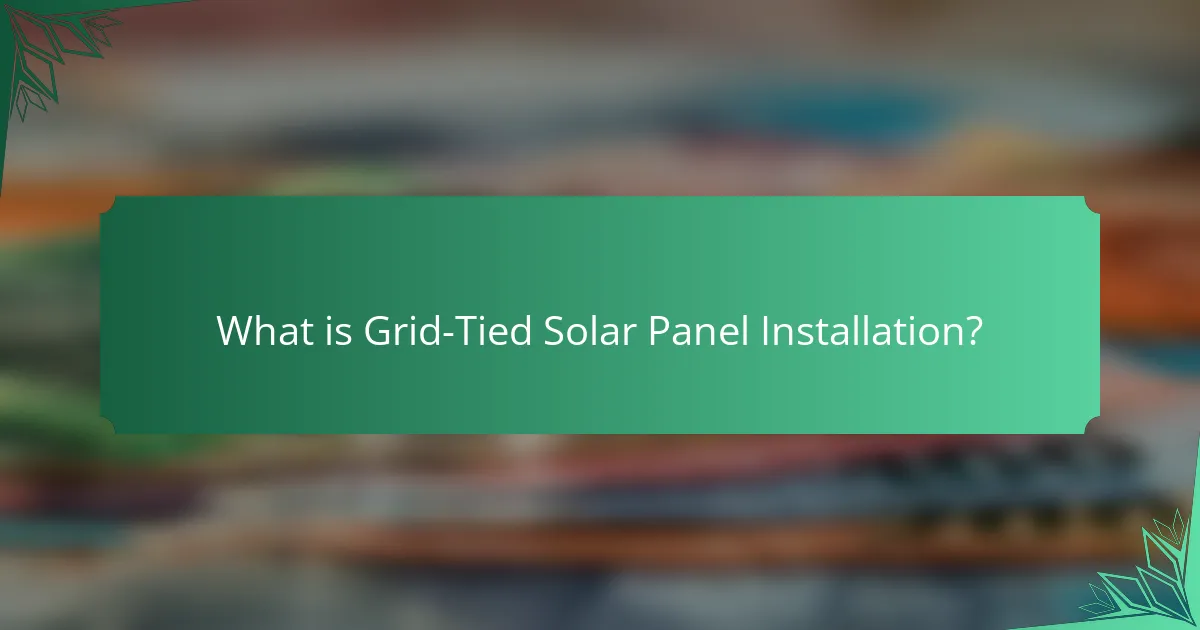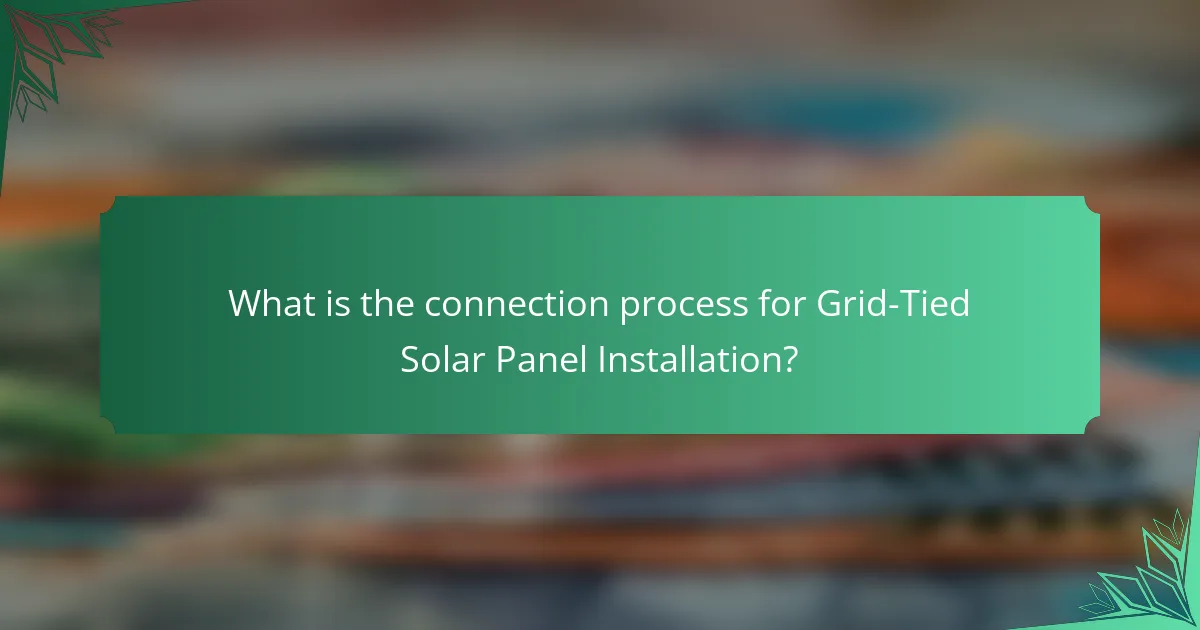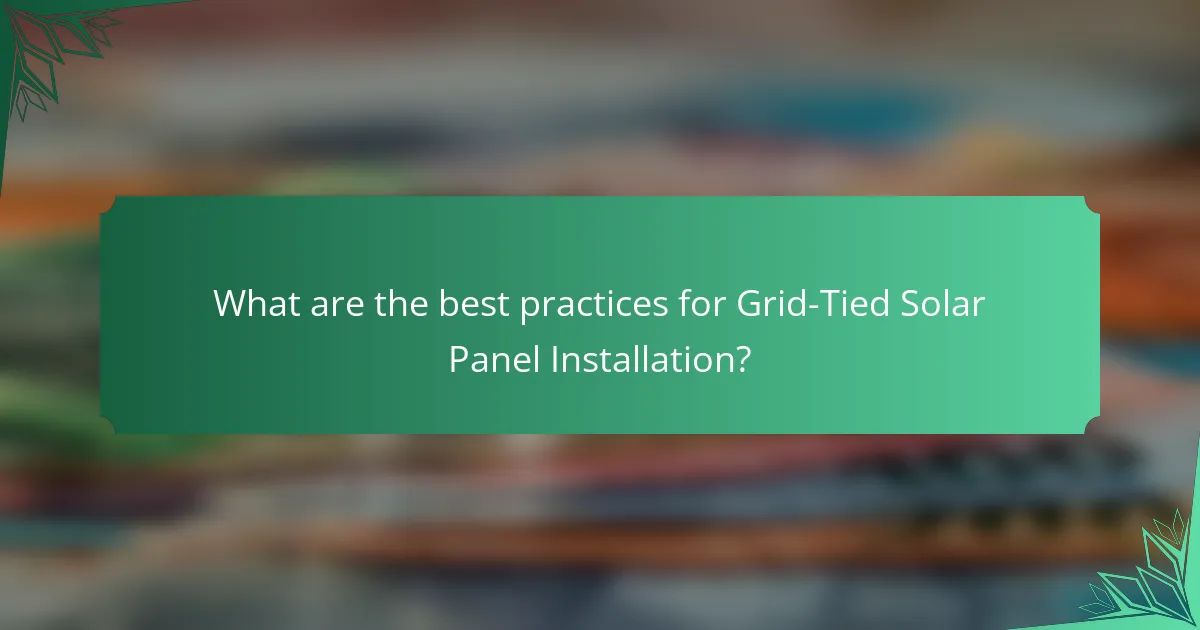
What is Grid-Tied Solar Panel Installation?
Grid-tied solar panel installation connects solar panels to the electrical grid. This system allows homeowners to generate their own electricity while remaining connected to the utility grid. When solar panels produce more energy than needed, excess electricity is sent back to the grid. This process can earn credits or reduce utility bills through net metering. Grid-tied systems do not require batteries, making them more cost-effective. They rely on the grid for energy when solar production is insufficient. According to the U.S. Department of Energy, grid-tied systems are the most common type of solar installation.
How does Grid-Tied Solar Panel Installation work?
Grid-tied solar panel installation connects solar panels to the utility grid. This system allows homeowners to generate electricity from sunlight while remaining connected to the grid. When the solar panels produce more electricity than the home consumes, the excess energy is sent back to the grid. This process is often facilitated by a net metering system, which credits the homeowner for the surplus energy produced. During periods of low sunlight, such as at night, the home draws electricity from the grid. Grid-tied systems do not require batteries, making them more cost-effective. According to the Solar Energy Industries Association, grid-tied systems account for the majority of solar installations in the U.S. due to their efficiency and lower upfront costs.
What are the essential components of a grid-tied solar panel system?
A grid-tied solar panel system consists of several essential components. The primary component is the solar panels, which convert sunlight into electricity. Next, the inverter transforms the direct current (DC) produced by the panels into alternating current (AC) for home use. The mounting system secures the solar panels to the roof or ground. Additionally, a grid connection allows excess electricity to be sent back to the utility grid. A meter measures the energy consumption and production. Lastly, safety disconnects ensure the system can be safely shut down. These components work together to create an efficient solar energy system that integrates with the existing power grid.
How do solar panels convert sunlight into electricity?
Solar panels convert sunlight into electricity through the photovoltaic effect. When sunlight hits the solar cells, it excites electrons, creating an electric current. Solar cells are typically made of silicon, a semiconductor material. The electric current generated is direct current (DC). An inverter then converts this DC into alternating current (AC) for use in homes. The efficiency of solar panels can vary, typically ranging from 15% to 22%. This conversion process is crucial for grid-tied solar systems, allowing excess electricity to be fed back into the grid.
What are the benefits of Grid-Tied Solar Panel Installation?
Grid-tied solar panel installation offers several benefits, including cost savings and energy efficiency. This system allows homeowners to generate their own electricity while remaining connected to the grid. When solar panels produce excess energy, it can be fed back into the grid. This process often results in credits on the homeowner’s utility bill, reducing overall energy costs. Additionally, grid-tied systems require less battery storage, which can lower upfront installation costs. According to the U.S. Department of Energy, solar energy can reduce electricity bills by 50% or more, depending on system size and energy usage. Furthermore, grid-tied systems contribute to a reduction in greenhouse gas emissions, promoting environmental sustainability. Overall, these benefits make grid-tied solar panel installations an attractive option for many homeowners.
How does Grid-Tied Solar Panel Installation reduce electricity costs?
Grid-tied solar panel installation reduces electricity costs by generating power directly from sunlight. This system allows homeowners to produce their own electricity, decreasing reliance on the grid. When solar panels generate more energy than needed, excess power can be sent back to the grid. Many utility companies offer credits for this excess energy, further lowering electricity bills. Additionally, solar energy is often cheaper than traditional electricity rates. According to the U.S. Department of Energy, homeowners can save thousands over the lifespan of the solar system. These savings are compounded by decreasing installation costs and available tax incentives. Overall, grid-tied systems provide a sustainable way to cut energy expenses.
What environmental advantages does Grid-Tied Solar Panel Installation offer?
Grid-tied solar panel installation offers significant environmental advantages. It reduces greenhouse gas emissions by decreasing reliance on fossil fuels. According to the U.S. Environmental Protection Agency, solar energy can offset approximately 0.5 to 1.5 tons of CO2 emissions per installed kilowatt annually. Solar panels also contribute to cleaner air by minimizing pollutants associated with traditional energy sources. Additionally, grid-tied systems promote sustainable energy use by allowing excess energy to be fed back into the grid. This reduces the need for energy production from non-renewable sources. Thus, grid-tied solar installations play a crucial role in promoting environmental sustainability.
Why choose Grid-Tied Solar Panel Installation over other systems?
Grid-tied solar panel installation is often preferred due to its cost-effectiveness and efficiency. This system allows homeowners to utilize solar energy while remaining connected to the utility grid. When solar panels produce excess energy, it can be fed back into the grid, often resulting in credits on electricity bills. This process is known as net metering and can significantly lower energy costs.
Additionally, grid-tied systems do not require expensive battery storage, making them more affordable to install and maintain. According to the U.S. Department of Energy, grid-tied systems are the most common type of solar installation, accounting for over 90% of all solar systems in the U.S. Their simplicity and reliance on existing infrastructure make them a practical choice for many homeowners.
What are the advantages of grid-tied systems compared to off-grid systems?
Grid-tied systems offer several advantages over off-grid systems. They provide access to the electrical grid, allowing for energy consumption even when solar production is low. This connection enables users to sell excess energy back to the grid, generating income or credits. Additionally, grid-tied systems typically require less battery storage, reducing initial costs and maintenance needs. They also simplify installation and system design due to the reliance on grid power. Furthermore, grid-tied systems often have more reliable energy supply due to the backup of the grid during outages. According to the U.S. Department of Energy, grid-tied systems can achieve higher overall efficiency by utilizing grid electricity when solar output is insufficient.
How does Grid-Tied Solar Panel Installation enhance energy efficiency?
Grid-tied solar panel installation enhances energy efficiency by allowing homeowners to utilize solar energy directly. This system connects to the local power grid, enabling the use of solar power during the day. Excess energy generated can be fed back into the grid, reducing reliance on traditional energy sources. During periods of low solar output, homeowners can draw energy from the grid without interruption. This integration minimizes energy waste and optimizes consumption. According to the U.S. Department of Energy, grid-tied systems can achieve up to 40% greater efficiency compared to off-grid systems. Additionally, net metering policies often credit homeowners for excess energy, providing financial incentives. This combination of factors leads to overall improved energy efficiency in residential settings.

What is the connection process for Grid-Tied Solar Panel Installation?
The connection process for grid-tied solar panel installation involves several key steps. First, the solar panels are mounted on the roof or ground. Next, the panels are connected to a solar inverter. The inverter converts the direct current (DC) generated by the panels into alternating current (AC). Following this, the AC electricity is connected to the home’s electrical system. The system is then connected to the utility grid through a bi-directional meter. This meter tracks electricity flow to and from the grid. Finally, local utility approval is obtained to ensure compliance with regulations. Proper installation ensures efficient energy use and potential savings on electricity bills.
How do you connect a grid-tied solar panel system to the electrical grid?
To connect a grid-tied solar panel system to the electrical grid, first, ensure the system complies with local regulations. Next, install an inverter that converts DC electricity from the panels to AC electricity compatible with the grid. Then, connect the inverter to the main electrical panel of your home. This connection allows electricity to flow between the solar system and the grid. After installation, request an inspection from your local utility company. They will verify the system’s compliance and safety. Once approved, the utility company will provide a net meter to track energy usage and production. This process enables you to sell excess energy back to the grid.
What are the steps involved in the connection process?
The steps involved in the connection process for grid-tied solar panel installation include several key actions. First, the solar panels are installed on the roof or ground. Next, the inverter is connected to convert direct current (DC) to alternating current (AC). Following this, the inverter is linked to the electrical panel of the home. Afterward, a connection to the utility grid is established. This may require obtaining permits and approvals from local authorities. Finally, the system is tested to ensure it operates correctly and safely. Each step is crucial for compliance and optimal performance of the solar energy system.
What permits are required for connecting to the grid?
To connect to the grid, several permits are typically required. These permits include an interconnection agreement with the utility company. Additionally, a building permit may be needed for the installation of solar panels. A zoning permit might also be necessary depending on local regulations. In some cases, a structural permit is required to ensure the roof can support the solar system. Local authorities may have specific requirements that must be met. Compliance with the National Electrical Code (NEC) is essential for safety standards. It is advisable to check with local government and utility providers for precise requirements.
What safety measures should be considered during the connection process?
Safety measures during the connection process of grid-tied solar panel installation include ensuring proper isolation from the grid. This prevents electrical shock during installation. Use personal protective equipment, such as gloves and goggles, to safeguard against electrical hazards. Verify that all equipment is compliant with local electrical codes to ensure safety standards are met. Conduct a thorough inspection of wiring and connections to avoid short circuits. Additionally, ensure that the inverter is properly grounded to mitigate electrical faults. Following these measures minimizes risks associated with the installation process.
How can you ensure compliance with local regulations?
To ensure compliance with local regulations, conduct thorough research on specific zoning laws and building codes. Review the requirements for grid-tied solar panel installations in your area. Obtain necessary permits before beginning installation. Engage with local authorities for guidance on compliance issues. Consult with a licensed contractor familiar with local regulations. Regularly check for updates to local laws that may affect your installation. Document all compliance efforts to maintain a clear record. These steps help avoid legal issues and ensure a successful installation process.
What are the common risks associated with the connection process?
Common risks associated with the connection process of grid-tied solar panel installation include electrical hazards, system incompatibility, and regulatory compliance issues. Electrical hazards can lead to shocks or fires if connections are improperly made. System incompatibility may result in performance inefficiencies or equipment damage. Regulatory compliance issues can cause delays or fines if local codes are not followed. According to the National Fire Protection Association, improper installations account for a significant percentage of electrical fires.

What are the best practices for Grid-Tied Solar Panel Installation?
The best practices for grid-tied solar panel installation include proper site assessment, optimal panel orientation, and ensuring compliance with local regulations. Conduct a thorough site assessment to evaluate sunlight exposure and potential shading from trees or buildings. Position solar panels to face true south for maximum energy capture in the Northern Hemisphere. Use high-quality mounting systems to secure panels and withstand local weather conditions. Ensure all electrical connections are performed by certified professionals to meet safety standards. Obtain necessary permits and adhere to local building codes for installation. Regular maintenance checks can enhance system efficiency and longevity. According to the National Renewable Energy Laboratory, proper installation can increase energy production by up to 30%.
How can you maximize the efficiency of your grid-tied solar panel system?
To maximize the efficiency of your grid-tied solar panel system, ensure optimal placement and angle of the panels. Position the panels to receive maximum sunlight exposure throughout the day. The ideal angle is typically between 30 to 45 degrees, depending on your geographical location. Regularly clean the panels to remove dirt and debris that can block sunlight.
Investing in high-efficiency solar panels can also enhance performance. These panels convert more sunlight into electricity compared to standard options. Additionally, using a quality inverter can improve energy conversion rates. Monitoring system performance with real-time data can help identify issues quickly.
According to the U.S. Department of Energy, properly maintained solar panel systems can achieve efficiency rates of 15-20%.
What maintenance practices should be followed for optimal performance?
Regular cleaning of solar panels is essential for optimal performance. Dust, dirt, and debris can significantly reduce energy output. Inspecting the system for any physical damage is also crucial. This includes checking for loose connections and damaged wiring. Monitoring the inverter’s performance ensures that the system operates efficiently. Keeping vegetation trimmed around the panels prevents shading. Scheduling professional maintenance annually can help identify issues early. These practices enhance the longevity and efficiency of grid-tied solar panel systems.
How often should you inspect your grid-tied solar panel system?
Inspect your grid-tied solar panel system at least twice a year. Regular inspections help identify potential issues early. They can prevent costly repairs and ensure optimal performance. Additionally, cleaning the panels every six months is recommended. This maintenance maximizes energy production. Dust and debris can significantly reduce efficiency. Following these guidelines can extend the lifespan of your system.
What troubleshooting tips are available for Grid-Tied Solar Panel Installation?
Check the inverter display for error codes. This display provides crucial information about system performance. Ensure all circuit breakers are in the ON position. This is essential for proper system operation. Inspect the wiring for loose connections or damage. Faulty wiring can lead to system failures. Verify that the solar panels are clean and free from obstructions. Dirt and debris can reduce energy production. Monitor energy output using a monitoring system. This helps identify any drops in performance. Consult the installation manual for specific troubleshooting steps. Manuals often contain manufacturer-specific guidance. If issues persist, contact a professional installer for assistance. They can provide expert analysis and solutions.
How can you identify common issues in grid-tied systems?
Common issues in grid-tied systems can be identified through regular monitoring and troubleshooting. Look for signs of underperformance, such as lower energy output than expected. Check for inverter errors or alerts, which indicate technical problems. Inspect wiring and connections for damage or corrosion, which can hinder performance. Evaluate the performance ratio, comparing actual output to the expected output, to spot discrepancies. Use performance monitoring software to track system efficiency over time. Conduct visual inspections for shading from trees or debris that could affect solar panel efficiency. These methods help ensure the system operates optimally and identifies issues early.
What steps should you take if your system is not performing as expected?
Check the system’s inverter for error codes. Error codes indicate specific issues with performance. Ensure that the solar panels are clean and free from debris. Dirt and grime can significantly reduce efficiency. Inspect the connections for any loose or damaged wiring. Poor connections can lead to energy loss. Verify that the system is receiving adequate sunlight. Shade from trees or buildings can hinder performance. Monitor the system’s performance data regularly. This helps identify trends or sudden drops in output. Contact a professional if issues persist. Experts can diagnose and resolve complex problems effectively.
Grid-tied solar panel installation is a system that connects solar panels to the electrical grid, enabling homeowners to generate their own electricity while remaining linked to the utility. The article outlines how these systems work, including their essential components, benefits such as cost savings and environmental advantages, and the connection process involving permits and safety measures. It also discusses best practices for installation, maintenance, and troubleshooting to maximize efficiency and performance. Key insights include the significance of net metering and the advantages of grid-tied systems over off-grid alternatives.